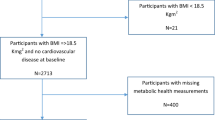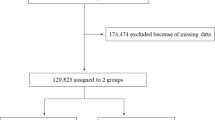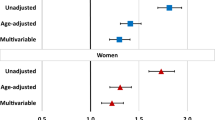Abstract
OBJECTIVE:
To evaluate the contributions of socioeconomic, lifestyle, and body weight factors to predicted risk of coronary heart disease (CHD) in the population and thus provide a focus for policies on prevention.
DESIGN:
Prospective study and cross-sectional population health survey.
SUBJECTS:
In all, 3090 men in the Framingham study and 2571 men in the 1998 Health Survey for England (HSE) aged 35–74 y with no history of cardiovascular disease participated in the study.
MEASUREMENTS:
Data on sex, age, systolic blood pressure and antihypertensive medication, total and high-density lipoprotein cholesterol levels, diabetes, and their association with the incidence of myocardial infarction and fatal CHD in the Framingham study population were used to derive functions for predicting individual 10-y risk of CHD. These functions were applied to the same data on participants in the HSE. High risk was defined as 10-y CHD risk ≥15%. The proportion of high risk in the English population attributable to each of the risk factors examined was assessed.
RESULTS:
In all, 32% of men in England had predicted 10-y CHD risk ≥15%. Such high risk was significantly associated with body mass index (BMI, kg/m2), waist:hip ratio (WHR), smoking, and levels of physical activity, educational attainment, and income (all P≤0.007). In this population, 47% of high CHD risk was attributable to excess body weight—BMI ≥25 kg/m2 and/or WHR ≥0.95—and 31% to the sum of the four other significant factors: lack of educational qualifications, low income, smoking, and physical inactivity.
CONCLUSION:
Overweight and obesity now dominate the standard risk factors of CHD in men and should be the focus of national policies for prevention.
This is a preview of subscription content, access via your institution
Access options
Subscribe to this journal
Receive 12 print issues and online access
$259.00 per year
only $21.58 per issue
Buy this article
- Purchase on Springer Link
- Instant access to full article PDF
Prices may be subject to local taxes which are calculated during checkout



Similar content being viewed by others
References
Department of Health. National Service Framework for Coronary Heart Disease. Department of Health: London; 2000.
Nanchahal K, Duncan JR, Durrington PN, Jackson RT . Analysis of predicted coronary heart disease risk in England based on Framingham study risk appraisal models published in 1991 and 2000. BMJ 2002; 325: 194–195.
Kunst AE, Groenhof F, Mackenbach JP, Health EW . Occupational class and cause specific mortality in middle aged men in 11 European countries: comparison of population based studies. EU Working Group on Scioeconomic Inequalities in Health. BMJ 1998; 316: 1636–1642.
Kilander L, Berglund L, Boberg M, Vessby B, Lithell H . Education, lifestyle factors and mortality from cardiovascular disease and cancer. A 25-year follow-up of Swedish 50-year-old men. Int J Epidemiol 2001; 30: 1119–1126.
Davey Smith G, Neaton JD, Wentworth D, Stamler R, Stamler J . Mortality differences between black and white men in the USA: contribution of income and other risk factors among men screened for the MRFIT. MRFIT Research Group. Multiple Risk Factor Intervention Trial. Lancet 1998; 351: 934–939.
Doll R, Peto R, Wheatly K, Gray R, Sutherland I . Mortality in relation to smoking: 40 years’ observations on male British doctors. BMJ 1994; 309: 901–911.
Hu FB, Willett WC . Optimal diets for prevention of coronary heart disease. JAMA 2002; 288: 2569–2578.
Morris JN . Exercise in the prevention of coronary heart disease: today's best buy in public health. Med Sci Sports Exerc 1994; 26: 807–814.
Jousilahti P, Tuomilehto J, Vartiainen E, Pekkanen J, Puska P . Body weight, cardiovascular risk factors and coronary mortality. 15-year follow-up of middle-aged men and women in eastern Finland. Circulation 1996; 93: 1372–1379.
Prevention of coronary heart disease in clinical practice. Recommendations of the Second Joint Task Force of European and other Societies on coronary prevention. Eur Heart J 1998; 19: 1434–1503.
Grundy SM, Paternak R, Greenland P, Smith Jr S, Fuster V . Assessment of cardiovascular risk by use of multiple-risk-factor assessment equations: a statement for healthcare professionals from the American Heart Association and the American College of Cardiology. Circulation 1999; 100: 1481–1492.
Anderson KM, Wilson PW, Odell PM, Kannel WB . An updated coronary risk profile: a statement for health professionals. Circulation 1991; 83: 356–362.
Erens B, Primatesta P (eds). Health Survey for England: Cardiovascular Disease. Volume 1: Findings. Volume 2: Methodology and Documentation. HMSO: London; 1999.
Greenland S, Drescher K . Maximum likelihood estimation of the attributable fraction from logistic models. Biometrics 1993; 49: 865–872.
D’Agostino Sr RB, Grundy S, Sullivan LM, Wilson P . CHD Risk Prediction Group. Validation of the Framingham coronary heart disease prediction scores: results of a multiple ethnic groups investigation. JAMA 2001; 286: 180–187.
Haq IU, Ramsay LE, Yeo WW, Jackson PR, Wallis EJ . Is the Framingham risk function valid for northern European populations. A comparison of methods for estimating absolute coronary risk in high risk men. Heart 1999; 81: 40–46.
Brindle P, Emberson J, Lampe F, Walker M, Whincup P, Fahey T, Ebrahim S . Predictive accuracy of the Framingham coronary risk score in British men: prospective cohort study. BMJ 2003; 327: 1267–1272.
World Health Organization. Obesity, preventing and managing the global epidemic. Report of a WHO Consultancy on Obesity. WHO: Geneva; 1997.
Molarius A, Seidell JC . Selection of anthropometric indicators for classification of abdominal fatness—a critical review. Int J Obes Relat Metab Disord 1998; 22: 719–727.
Lakka HM, Lakka TA, Tuomilehto J, Salonen JT . Abdominal obesity is associated with increased risk of acute coronary events in men. Eur Heart J 2002; 23: 706–713.
Wilson PW, D’Agostino RB, Sullivan L, Parise H, Kannel WB . Overweight and obesity as determinants of cardiovascular risk: the Framingham experience. Arch Intern Med 2002; 162: 1867–1872.
Katzmarzyk PT, Ardern CI . Overweight and obesity mortality trends in Canada, 1985–2000. Can J Public Health 2004; 95: 16–20.
National Heart, Lung, and Blood Institute and North American Association for the Study of Obesity. The Practical Guide to the Identification, Evaluation, and Treatment of Overweight and Obesity in Adults, Bethesda, MD, NIH publication no. 00-4084; 2000 (also available from http://www.nhlbi.nih.gov/guidelines/obesity/practgde.htm ).
Anderson JW, Konz EC, Frederich RC, Wood CL . Long-term weight-loss maintenance: a meta-analysis of US studies. Am J Clin Nutr 2001; 74: 579–584.
Dyer AR, Stamler J, Garside D, Greenland P . Long-term consequences of body mass index for cardiovascular mortality: The Chicago heart association detection project in industry. Ann Epidemiol 2004; 14: 101–108.
Unal B, Critchley JA, Capewell S . Explaining the decline in coronary heart disease mortality in England and Wales between 1981 and 2000. Circulation 2004; 109: 1101–1107.
Acknowledgements
This research was partly supported by NIH N-01-38038, NIH R01-HL-073272, and a grant from the Donald W Reynolds Foundation Programme in Clinical Cardiovascular Research.
Author information
Authors and Affiliations
Corresponding author
Rights and permissions
About this article
Cite this article
Nanchahal, K., Morris, J., Sullivan, L. et al. Coronary heart disease risk in men and the epidemic of overweight and obesity. Int J Obes 29, 317–323 (2005). https://doi.org/10.1038/sj.ijo.0802877
Received:
Revised:
Accepted:
Published:
Issue Date:
DOI: https://doi.org/10.1038/sj.ijo.0802877
Keywords
This article is cited by
-
Overweight status is associated with extensive signs of microvascular dysfunction and cardiovascular risk
Scientific Reports (2016)
-
Inhibitory activity of extracts of Hebridean brown seaweeds on lipase activity
Journal of Applied Phycology (2016)
-
Green tea polyphenol extract in vivo attenuates inflammatory features of neutrophils from obese rats
European Journal of Nutrition (2016)
-
Lifestyle Intervention Leading to Moderate Weight Loss Normalizes Postprandial Triacylglycerolemia Despite Persisting Obesity
Obesity (2011)
-
Comparison of two methods for identifying dietary patterns associated with obesity in preschool children: the GENESIS study
European Journal of Clinical Nutrition (2010)



